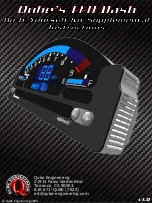
184
STARTING AND OPERATING
vehicle's momentum and do not stop. The
key to driving in soft sand is using the appro
-
priate tire pressure, accelerating slowly,
avoiding abrupt maneuvers and maintaining
the vehicle's momentum. If you are going to
be driving on large soft sandy areas or dunes,
reduce your tire pressure to a minimum of
15 psi (103 kPa) to allow for a greater tire
surface area. Reduced tire pressure will dras
-
tically improve your traction and handling,
while driving on the soft sand, but you must
return the tires to normal air pressure before
driving on pavement or other hard surfaces.
Be sure you have a way to air the tires back
up prior to reducing the pressure.
C
ROSSING
O
BSTACLES
(R
OCKS
A
ND
O
THER
H
IGH
P
OINTS
)
While driving off road, you will encounter many
types of terrain. These varying types of terrain
bring different types of obstacles. Before
proceeding review the path ahead to determine
the correct approach and your ability to safely
recover the vehicle if something goes wrong.
Keeping a firm grip on the steering wheel, bring
the vehicle to a complete stop and then inch the
vehicle forward until it makes contact with the
object. Apply the throttle lightly while holding a
light brake pressure and ease the vehicle up
and over the object.
Using A Spotter
There are many times where it is hard to see the
obstacle or determine the correct path.
Determining the correct path can be extremely
difficult when you are confronting many
obstacles. In these cases have someone guide
you over, through, or around the obstacle. Have
the person stand a safe distance in front of you
where they can see the obstacle, watch your
tires and undercarriage, and guide you through.
Crossing Large Rocks
When approaching large rocks, choose a path
which ensures you drive over the largest with
your tires. This will lift your undercarriage over
the obstacle. The tread of the tire is tougher and
thicker than the side wall and is designed to
take the abuse. Always look ahead and make
every effort to cross the large rocks with your
tires.
Crossing A Ravine, Gully, Ditch, Washout
Or Rut
When crossing a ravine, gully, ditch, washout or
a large rut, the angled approach is the key to
maintaining your vehicle's mobility. Approach
these obstacles at a 45-degree angle and let
each tire go through the obstacle independently.
You need to use caution when crossing large
obstacles with steep sides. Do not attempt to
CAUTION!
Reduced tire pressures may cause tire
unseating and total loss of air pressure. To
reduce the risk of tire unseating, while at a
reduced tire pressure, reduce your speed and
avoid sharp turns or abrupt maneuvers.
WARNING!
Crossing obstacles can cause abrupt steering
system loading which could cause you to
loose control of your vehicle.
CAUTION!
Never attempt to straddle a rock that is
large enough to strike your axles or under
-
carriage.
Never attempt to drive over a rock which is
large enough to contact the door sills.
21_DJD2_OM_EN_USC_t.book Page 184
















































